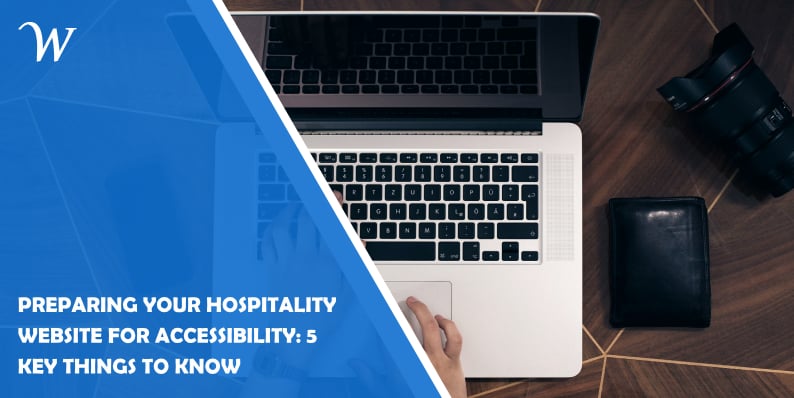In today’s digitally-driven world, ensuring your hospitality website is accessible to all users is not just a best practice; it’s a necessity. As the digital face of your brand, your website must cater to a diverse range of visitors, including those with disabilities. While legal frameworks provide a backdrop for these efforts, the focus here extends beyond compliance. It’s about enhancing user experience, ensuring inclusion, and recognizing the value that each visitor brings to your digital doorstep. These tenets are behind pioneering companies like accessiBe who champion web accessibility.
In this article, we delve into five essential considerations for making your hospitality website not just accessible, but welcoming to everyone. From intuitive navigation to compatibility with assistive technologies, these key insights will help you create a digital space that truly resonates with all your guests. Let’s explore how to build a more inclusive online presence in the hospitality sector.
Recognizing Diverse User Requirements
In the hospitality industry, understanding and catering to a wide spectrum of user needs is fundamental. Your website is often the first point of interaction with your brand, and it’s vital that this experience is accessible to everyone. People with disabilities, ranging from visual and hearing impairments to motor and cognitive challenges, require websites that are thoughtfully designed to address their specific needs. This isn’t just about removing barriers; it’s about actively creating an inviting and inclusive digital environment. By acknowledging the diversity of your users, you are not only complying with best practices but also demonstrating a commitment to all guests, reflecting the hospitable spirit of your industry.
Core Elements of an Accessible Website
Creating an accessible hospitality website involves several key elements that enhance usability for all. Firstly, navigation should be intuitive and straightforward. This means having a clear, consistent layout with easy-to-locate menus and links. Next, readability is crucial. Selecting fonts that are easy to read, providing sufficient color contrast, and allowing users to adjust text sizes are all important factors. Finally, consider your media content. Images should have descriptive alt-texts, and videos should include subtitles or captions. These features not only aid those with specific impairments but also enhance the overall user experience, making your website more inviting and user-friendly for everyone.
Enhancing Interactive Website Features
Interactive features are a cornerstone of modern hospitality websites, offering convenience and engagement for visitors. To ensure these features are accessible, special attention is needed. Online booking systems, for instance, should be designed so that they can be easily navigated with a keyboard or screen reader. Virtual tours, increasingly popular in the hospitality industry, must be made accessible by providing alternative text descriptions or audio guides. Furthermore, feedback forms, which are essential for guest interaction and service improvement, should be accessible to all users, including those using assistive technologies. By enhancing the accessibility of these interactive elements, you not only comply with best practices but also provide a seamless and inclusive experience for all your guests.
Compatibility with Assisstive Technologies
An essential aspect of web accessibility is ensuring that your site is compatible with assistive technologies. These technologies, such as screen readers, magnification software, and voice recognition tools, are used by many people with disabilities to navigate the internet. To make your hospitality website accessible, it should work seamlessly with these tools. This means testing with different assistive technologies to identify and resolve any potential barriers. Such compatibility not only aids in providing equal access to information and services but also ensures that all users, regardless of their physical abilities, can independently interact with your website, embodying the true essence of hospitality.
The Importance of User Testing
User testing is a critical step in ensuring web accessibility. While automated tools can identify some issues, real user testing – especially involving people with disabilities – provides invaluable insights into the user experience. It helps to uncover practical challenges that might not be immediately obvious. Encouraging feedback from a diverse group of users, including those with disabilities, can lead to meaningful improvements in your website’s accessibility. This approach not only enhances the user experience but also demonstrates a commitment to truly understanding and meeting the needs of all guests, which is at the heart of the hospitality industry.
Building a Welcoming Digital Future in Hospitality
Preparing your hospitality website for accessibility is a vital step towards creating an inclusive and welcoming digital environment for all users. By recognizing diverse user needs, implementing core accessibility elements, enhancing interactive features, ensuring compatibility with assistive technologies, conducting thorough user testing, and maintaining a commitment to ongoing accessibility, you can offer an exemplary online experience. Such efforts not only reflect the hospitable spirit and service excellence of your brand but also contribute to building a more accessible and inclusive digital future in the hospitality industry. Remember, an accessible website is more than a compliance checkbox; it’s a gateway to providing exceptional service and creating lasting, positive experiences for every guest.
